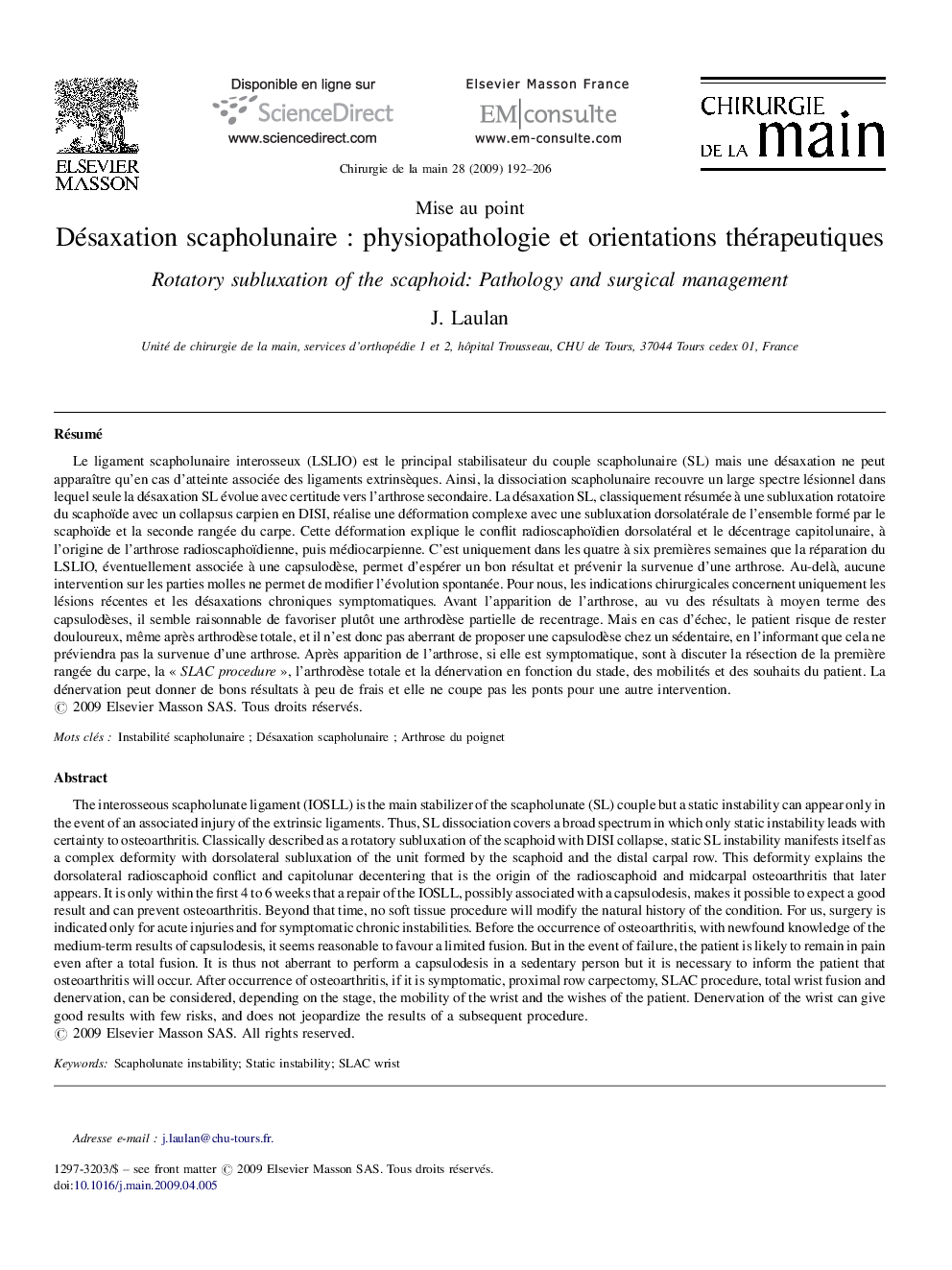| Article ID | Journal | Published Year | Pages | File Type |
|---|---|---|---|---|
| 4049690 | Chirurgie de la Main | 2009 | 15 Pages |
RésuméLe ligament scapholunaire interosseux (LSLIO) est le principal stabilisateur du couple scapholunaire (SL) mais une désaxation ne peut apparaître qu’en cas d’atteinte associée des ligaments extrinsèques. Ainsi, la dissociation scapholunaire recouvre un large spectre lésionnel dans lequel seule la désaxation SL évolue avec certitude vers l’arthrose secondaire. La désaxation SL, classiquement résumée à une subluxation rotatoire du scaphoïde avec un collapsus carpien en DISI, réalise une déformation complexe avec une subluxation dorsolatérale de l’ensemble formé par le scaphoïde et la seconde rangée du carpe. Cette déformation explique le conflit radioscaphoïdien dorsolatéral et le décentrage capitolunaire, à l’origine de l’arthrose radioscaphoïdienne, puis médiocarpienne. C’est uniquement dans les quatre à six premières semaines que la réparation du LSLIO, éventuellement associée à une capsulodèse, permet d’espérer un bon résultat et prévenir la survenue d’une arthrose. Au-delà, aucune intervention sur les parties molles ne permet de modifier l’évolution spontanée. Pour nous, les indications chirurgicales concernent uniquement les lésions récentes et les désaxations chroniques symptomatiques. Avant l’apparition de l’arthrose, au vu des résultats à moyen terme des capsulodèses, il semble raisonnable de favoriser plutôt une arthrodèse partielle de recentrage. Mais en cas d’échec, le patient risque de rester douloureux, même après arthrodèse totale, et il n’est donc pas aberrant de proposer une capsulodèse chez un sédentaire, en l’informant que cela ne préviendra pas la survenue d’une arthrose. Après apparition de l’arthrose, si elle est symptomatique, sont à discuter la résection de la première rangée du carpe, la « SLAC procedure », l’arthrodèse totale et la dénervation en fonction du stade, des mobilités et des souhaits du patient. La dénervation peut donner de bons résultats à peu de frais et elle ne coupe pas les ponts pour une autre intervention.
The interosseous scapholunate ligament (IOSLL) is the main stabilizer of the scapholunate (SL) couple but a static instability can appear only in the event of an associated injury of the extrinsic ligaments. Thus, SL dissociation covers a broad spectrum in which only static instability leads with certainty to osteoarthritis. Classically described as a rotatory subluxation of the scaphoid with DISI collapse, static SL instability manifests itself as a complex deformity with dorsolateral subluxation of the unit formed by the scaphoid and the distal carpal row. This deformity explains the dorsolateral radioscaphoid conflict and capitolunar decentering that is the origin of the radioscaphoid and midcarpal osteoarthritis that later appears. It is only within the first 4 to 6 weeks that a repair of the IOSLL, possibly associated with a capsulodesis, makes it possible to expect a good result and can prevent osteoarthritis. Beyond that time, no soft tissue procedure will modify the natural history of the condition. For us, surgery is indicated only for acute injuries and for symptomatic chronic instabilities. Before the occurrence of osteoarthritis, with newfound knowledge of the medium-term results of capsulodesis, it seems reasonable to favour a limited fusion. But in the event of failure, the patient is likely to remain in pain even after a total fusion. It is thus not aberrant to perform a capsulodesis in a sedentary person but it is necessary to inform the patient that osteoarthritis will occur. After occurrence of osteoarthritis, if it is symptomatic, proximal row carpectomy, SLAC procedure, total wrist fusion and denervation, can be considered, depending on the stage, the mobility of the wrist and the wishes of the patient. Denervation of the wrist can give good results with few risks, and does not jeopardize the results of a subsequent procedure.
